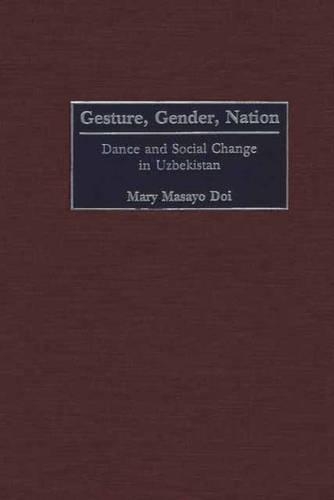
Gesture, Gender, Nation: Dance and Social Change in Uzbekistan
(Hardback)
Publishing Details
Gesture, Gender, Nation: Dance and Social Change in Uzbekistan
By (Author) Mary M. Doi
Bloomsbury Publishing PLC
Praeger Publishers Inc
30th November 2001
United States
Classifications
Tertiary Education
Non Fiction
Anthropology
Childrens / Teenage general interest: Dance, ballet
Gender studies, gender groups
Regional / International studies
306.48409587
Physical Properties
Hardback
168
Description
The national dancers of Uzbekistan are almost always female. In a society that has been Muslim for nearly seven hundred years, why and how did unveiled female dancers become a beloved national icon during the Soviet period Also, why has their popularity continued after the Uzbek republic became independent The author argues that dancers, as symbolic "girls" or unmarried females in the Uzbek kinship system, are effective mediators between extended kin groups, and the Uzbek nation-state. The female dancing body became a "tabula rasa" upon which the state inscribed, and reinscribed, constructions of "Uzbek" nationalism.
Reviews
[O]one of the first contemporary studies of Uzbek expressive arts.-Slavic Review
[T]he author has done a fine job of introducing readers to the art form....Her descriptive writing is clear and concise, and her honesty in relating her own fieldwork experiences is worthy of praise. This book will be a useful platform from which other Central Asian dance researchers can dive further into this fascinating subject.-Journal of American Folklore
Scholars are in her debt for showing a fascinating new area of inquiry.-The Russian Review
"Oone of the first contemporary studies of Uzbek expressive arts."-Slavic Review
"The author has done a fine job of introducing readers to the art form....Her descriptive writing is clear and concise, and her honesty in relating her own fieldwork experiences is worthy of praise. This book will be a useful platform from which other Central Asian dance researchers can dive further into this fascinating subject."-Journal of American Folklore
"[O]one of the first contemporary studies of Uzbek expressive arts."-Slavic Review
"Scholars are in her debt for showing a fascinating new area of inquiry."-The Russian Review
"[T]he author has done a fine job of introducing readers to the art form....Her descriptive writing is clear and concise, and her honesty in relating her own fieldwork experiences is worthy of praise. This book will be a useful platform from which other Central Asian dance researchers can dive further into this fascinating subject."-Journal of American Folklore
Author Bio
MARY MASAYO DOI is Assistant Professor of Anthropology, Bryn Mawr College.
